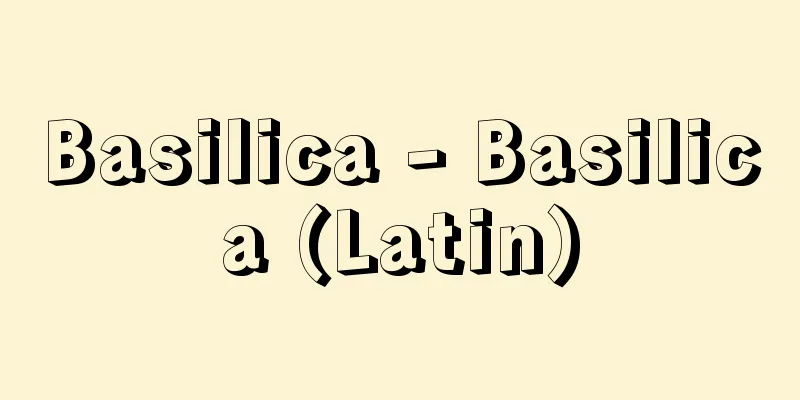Basilica - Basilica (Latin)

|
The name of a public building in ancient Rome that served as both a marketplace and a courtroom. The term originally referred to a large hall surrounded by a colonnade inside the building. The Basilica of Aemilius, built in Rome in the first half of the 2nd century BC, is the earliest example of this type of building, and judging from its foundations, it was a building with a roofed hall in the Forum Romanum (public square), the core of the city of Rome, and people could freely pass through the colonnade. The basilicas from the late 2nd century BC, whose foundations remain in Pompeii, have a rectangular plan surrounded by walls, like those in other Mediterranean cities other than Italy, with an atrium (front gallery) at one end of the short side and a judge's seat at the other end. The central part of the hall is surrounded by a colonnade, and the judge's seat is surrounded by a colonnade. In addition, the Basilica of Maxentius in Rome (also known as the Basilica of Constantine after the name of its completer), which was completed in the first half of the 4th century AD when structural construction techniques were well developed, has a structure in which cross vaults are supported by buttresses instead of columns. The promulgation of the Edict Protecting Christianity by Emperor Constantine in the early 4th century encouraged the construction of Christian churches, but the architects of the time, faced with this new architectural challenge, rushed to build churches based on the basic form of the early basilicas of ancient Rome. This is how the so-called basilica style churches were realized. These buildings are rectangular buildings surrounded by stone walls and covered with timber-framed roofs, and the back wall facing the main entrance forms a semicircular apse, in the center of which is the altar. The interior is divided into a nave and three to five aisles (left and right aisles) by two to four rows of columns, and between the entrance and the nave is an atrium (vestibular area) and a narthex (entrance hall). The last bay of the nave forms the sanctuary, where the choir stalls are located, surrounded by a fence. Most of the churches of this type in Rome that were founded in the 4th and 5th centuries were subsequently rebuilt or partially altered after fires and other destruction, so there are no examples that remain in the same condition as when they were first built. The word basilica is also used to indicate the status of a church, and refers to a church that has been granted superiority by the Pope, second only to a cathedral. [Katsuya Hamatani] [Reference item] |A basilica in the Roman Forum (Foro Romano), a ruin remaining in Rome. Built in the early 4th century. Also known as the "Basilica of Constantine." Currently, only the northern aisle remains. Part of the World Heritage Site "Historic Centre of Rome, the Papal States and the Basilica of St. Paul the Fori le Mura" (Italy/Vatican City, registered in 1980 and 1990) Italy Rome ©Shogakukan "> Basilica of Maxentius Source: Shogakukan Encyclopedia Nipponica About Encyclopedia Nipponica Information | Legend |
|
古代ローマの市場と法廷を兼備した公共建造物の呼称。このことばは、もともと建造物の内部の柱廊で囲まれた広間をさすものであった。紀元前2世紀前期、ローマに建てられたアエミリウスのバシリカはこの種の建造物のもっとも初期の事例であるが、礎石から推測すると、ローマ市の中核をなすフォルム・ロマヌム(公共広場)に所属する、屋根が架せられた広間をもつ建造物で、人々は自由に柱廊を通り抜けできるような構造であったことがわかる。ポンペイに礎石を残している前2世紀末期のバシリカでは、イタリア以外の地中海中部の諸都市のそれと同じように、壁体で囲まれた長方形のプランであり、短辺の端にアトリウム(前廊)が設けられ、他の端には裁判官席があった。広間の中部四囲は柱廊が巡らされ、裁判官席は列柱で囲まれている。また、架構法の発達した紀元後4世紀前半に完成したローマのマクセンティウスのバシリカ(完成者の名にちなみコンスタンティヌスのバシリカの呼称もある)は、交差穹窿(きゅうりゅう)を円柱のかわりに支壁で支える構造となっている。 4世紀初頭のコンスタンティヌス大帝によるキリスト教保護令の公布は、キリスト教聖堂の建立を促すことになるが、この新しい建築課題に直面した当時の建築家たちは、古代ローマの初期バシリカに基本形式を求めて聖堂を急造することになった。こうして実現されたのがいわゆるバシリカ式聖堂である。これらの建造物は石の壁体で囲まれ、木組みの屋根が架せられた長方形の建物で、正面入口と向き合う奥の壁体は半円形に張り出すアプスを形成し、その中央に祭壇が設けられる。堂内は2列ないし4列に並ぶ円柱によって、身廊と左右側廊の3廊ないし5廊に分けられるが、入口と身廊部との間にはアトリウム(前庭部)とナルテックス(玄関の間)が介在する。身廊の最終柱間は内陣部をなし、障柵(しょうさく)で囲まれた聖歌隊席が置かれる。4、5世紀に創建されたローマのこの種の聖堂は、その後、火災その他の破壊を受けて改築されたり部分的に改造されたため、創建当時の状態をそのまま伝える事例は皆無である。 なおバシリカの語は、聖堂の格式を示すものとしても用いられ、ローマ教皇により大聖堂(カテドラル)に次ぐ上席権を与えられた聖堂をさす。 [濱谷勝也] [参照項目] |ローマに残る遺跡フォルム・ロマヌム(フォロ・ロマーノ)にあるバシリカ。4世紀初頭の建造。「コンスタンティヌスのバシリカ」ともよばれる。現在は北側の側廊にあたる部分のみが残る。世界文化遺産「ローマ歴史地区、教皇領とサンパオロ・フォーリ・レ・ムーラ大聖堂」の一部(イタリア/バチカン市国・1980、1990年登録) イタリア ローマ©Shogakukan"> マクセンティウスのバシリカ 出典 小学館 日本大百科全書(ニッポニカ)日本大百科全書(ニッポニカ)について 情報 | 凡例 |
<<: Basilicata (English spelling)
>>: Basilan Island (English spelling)
Recommend
Apo [mountain] - Apo
A volcano located southwest of Davao City in the s...
Raffia (English spelling)
A city in central Nigeria. Located about 160 km so...
Enemy
Aesthetic sense in the late Edo period. Shikitei S...
Hosho - Hosho
A document issued by a vassal to convey the will ...
Substructure - Kabukozo (English spelling) Unterbau German
In historical materialism (Marxist social science...
tunica serosa (English spelling) tunica serosa
…【Marina Dan】(2) Medical term. The three cavities...
Soma [village] - Soma
A village in Nakatsugaru County, southern Aomori P...
Méhul, Étienne-Nicolas
Born: June 22, 1763, Givet, Ardennes [Died] Octobe...
Kusaya
A type of salted dried fish made from horse macke...
New born chick; baby chick
Newly hatched chicken chicks. Raising day-old chic...
Chihaya Castle
This mountain castle was located in Chihayaakasaka...
Himekawa
It is a first-class river that flows through the ...
Interpretation - tsuuyaku
〘noun〙 A person who translates between people who ...
Pungitius sinensis (English spelling) Pungitiussinensis
…[Isao Hanyu]. … *Some of the terms mentioned in ...
Black mountain ant - Kuroyamaari
This insect belongs to the family Formicidae in t...









